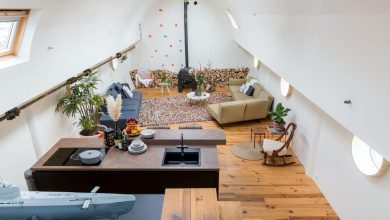How Do You Create a Container Garden? Start Here.

It’s a spring ritual: shopping for plants to fill this year’s pots.
The first plant I grab always involves a bit of a ritual, too, aimed at preventing impulse buys that won’t add up to anything visually coherent once I’m back home. I start with a plant with multicolored leaves — an especially showy Coleus, a fancy-leaf begonia houseplant or maybe a copperleaf plant (Acalypha).
The color scheme in the plant’s leaves becomes my inspiration as I look to make pleasing combinations from the options lining the garden-center benches.
I latched onto this strategy years ago after I heard Bob Hyland suggest it to a group of gardeners at his former nursery in the Hudson Valley — one of various ideas he shared to help focus their container planning.

At his home in Oregon, Bob Hyland combined two favorite annuals, Calibrachoa Superbells Dreamsicle and Supertunia Honey petunia, with a linear, silver-green central element, Astelia banksii.Credit…Bob Hyland
Mr. Hyland, a past vice president of horticulture at Brooklyn Botanic Garden, has since relocated to Portland, Ore., where he designs gardens, including container displays for clients in the local restaurant industry. Ten years ago, he opened a shop specializing in pots and their design. He calls it Contained Exuberance. The words may sound contradictory, but they represent another piece of his advice: While your plants may be constrained by the limits of a pot, that doesn’t mean your creativity should be restricted.
From the choice and arrangement of your pots to an expanded vision of what goes in them — not just annuals, but houseplants and young trees, too — Mr. Hyland has guidance you may wish to borrow, as I did his leaf trick.
First Come the Pots
Before heading to the garden center, Mr. Hyland advised, get out your pots and set them roughly in place where you plan to use them. Would adding differently shaped ones strengthen the vignettes?
“The pot is almost as important as the plants, in my mind,” he said. “Its shape, surface texture, color — because you’re going to be staring at that for a long time.”
A much-repeated container design formula calls for combining three botanical elements: a thriller, a filler and a spiller. The vertical thriller (perhaps a Phormium or Cordyline, or in larger containers a canna or banana) is nestled in a midlevel filler (something grassy looking).
A vine like the boldly variegated Algerian ivy (Hedera algeriensis Gloire de Marengo) could scramble at ground level and over the edge. One of the looser ground-cover sedums, like golden Angelina, could work, too.
But thriller-filler-spiller is an informal recipe, Mr. Hyland said. It’s a reminder to hit various notes with your compositions, rather than repeat too much of the same, in pot after pot — unless the context is formal or starkly modern and that’s the point.
“One pot in a grouping could be the thriller,” he said. “You don’t have to carry that idea into the planting in every individual pot, if you think about the groupings and the shapes of your pot ensembles.”
Scale-wise, look beyond the unexceptional proportions of the average flower pot. Try a dramatic, upright cylindrical container that is waist height or taller to elevate plants into closer view.
During hellebore season, Mr. Hyland added some to a tall planter outside the door of a client’s restaurant. Hellebores, of ground-cover stature, usually require us to bend down for a good look. This put them front and center, surrounding a Phormium amid an effusion of variegated Japanese sedge (Carex oshimensis Everest), part of the EverColor series of ornamental sedges that he calls “my go-to fillers.” After their close-up, the hellebores go in the ground.
Maybe add a low, bowl-shaped vessel, too. In any shape, bigger is better, Mr. Hyland said, not just for impact, but to withstand increasing climate rigors and reduce maintenance. Smaller pots heat up and dry out faster, while the greater soil volume in larger pots offers better root insulation and moisture retention.
“More than ever, I’m conscious of ‘right plant, right place’ — and right pot,” he said.
It’s not just a West Coast consideration. “When I do containers, it is all about low maintenance, minimal deadheading and not too thirsty,” said Katherine Tracy, of Avant Gardens, a friend of Mr. Hyland’s with a design firm and nursery in Dartmouth, Mass.
The color of the container can play off your home’s siding or trim paint, or mimic an architectural element like stone or steel. But easy does it. “I’m not big on bright, bold colors. I think they often detract from the plantings,” he said. “My go-to is often a gray, concrete look or dark brown earthenware.”
Lately, Mr. Hyland finds himself gravitating toward muted blue and teal tones. These colors are harmonious with the water-wise plants — many of which have foliage with a silvery or blue-green cast — that he is using more consciously as summers get harder.
Not Just Annuals: From Trees and Shrubs to Houseplants
The garden-center annuals and tropicals screaming for adoption get some space in Mr. Hyland’s containers, but they don’t form his primary palette.
Plants that have proved themselves consistent performers always make his shopping list, including the Superbells series of Calibrachoa and the Supertunia petunias, particularly Honey and Bordeaux. He also relies on Sorbet violas.
Salvias (like S. microphylla Hot Lips, with its red-and-white flowers) make a good filler, and he often uses begonias, too. Begonia boliviensis Bonfire and tuberous Begonia sutherlandii, both of which have orange blooms, are regulars. So are the upright ones from the houseplant department, their leaves a mosaic of greens, wines and silver.
Before all that, though, Mr. Hyland puts the structural plants in place, including the trees and shrubs that can make a semi-permanent home in large containers.
Some pots will hold strikingly vertical elements, like a yew (Taxus baccata Fastigiata or Standishii) or boxwood (Buxus sempervirens Graham Blandy or Green Tower).
As for woody plants, the compact varieties are the best adapted to pots. But even the ones that will eventually grow larger can do years of service in a pot before going into the ground. In colder zones, the pot must be large (for root insulation) and weatherproof, and the plant perhaps a zone hardier than where you garden. (For extra protection, I stash my assortment of potted Japanese maples in an unheated garage in Zone 5b, for instance.)
Ideally, Mr. Hyland said, you should remove the tree or shrub from its pot and root-prune it every few years, before repotting it with fresh soil. At the very least, change out the top several inches of soil annually.
Not that he always follows his own advice. “I laugh at myself, because I have containers out in front of restaurants with woody plants in them for many years,” he said. “It’s like as long as you keep watering those, they seem to keep going. It’s like bonsai-ing a plant.”
Leaves, Leaves, Leaves
Even if you don’t start your shopping trip by choosing a plant for its foliage, the leaves are typically the glue of a design, Mr. Hyland said. (“Needless to say, it’s often about the foliage,” echoed Ms. Tracy, who uses succulents lavishly.)
Showy leaves “may be lurking in the houseplant department,” he said, on plants that can transition to an indoor location before the first frost.
Or look among the perennial ground covers. Chinese wintercreeper (Parthenocissus henryana) makes a dramatic spiller, he said. Bolder-leaf Ajugas (like Black Scallop, Chocolate Chip or Burgundy Glow) don’t spill, but creep along, softening pot edges. Where he wants a finer texture, creeping thyme is a go-to.
Another perennial that he and Ms. Tracy often call into foliar service: Heuchera. Georgia Peach and Caramel lend warm tones, Plum Pudding offers purple, and Citronelle provides a splash of chartreuse. Even hostas command some container real estate — especially June, with its stunning near-turquoise foliage with chartreuse centers.
Maybe there’s a spot at the lip of a pot for silver sage (Salvia argentea) or angel wings sea cabbage (Senecio candicans), with its ample rosettes of sterling fuzziness?
Those finishing touches, Mr. Hyland said, are “like putting a bow on the container.”
Nuts and Bolts: Planting and Care Tips
Mr. Hyland strives for “a layered, naturalistic, textural look with multi-season interest,” delivered by maybe three to five plants at the most.
Those big, artfully arranged hanging baskets of a half-dozen or more kinds of plants that you see at the garden center are groomed to peak in time for Mother’s Day sales and probably won’t look artful for long. “What do they look like at Father’s Day — or the Fourth of July?” he asked.
In other words: Don’t overcomplicate your container designs.
Mr. Hyland offered a few other tips. When you’re filling an extra-large (or extra-tall) pot, place a piece of screening in the bottom, covered in an inch or two of gravel. Then fill the bottom third with shredded-bark mulch before adding the potting soil.
Feed your container plants, but not too much: Mr. Hyland applies a granular, slow-release fertilizer like Osmocote Plus (its N-P-K ratio is 15-9-12) when he is planting pots, and he replenishes it each spring in his permanent planters. Overfertilizing, he warns, can push excess growth that makes plants thirstier.
And finally: Water well, and repeat. When it is time to water, he moistens each pot thoroughly — no matter its size — three times at every watering. His favorite nozzle for delivering a slow flow that really soaks in is the Dramm Redhead on a watering wand with an adjustable-flow valve. Not the nozzle you use to wash the car, please.
Margaret Roach is the creator of the website and podcast A Way to Garden, and a book of the same name.
For weekly email updates on residential real estate news, sign up here.



